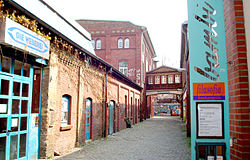The weaving mill (Gütersloh)
| former weaving mill Greve & Güth | |
|---|---|
 View into Bogenstraße, on the right in the foreground the art house cinema bambi |
|
| Data | |
| place |
|
| Construction year | 1874/1901 |
| Coordinates | 51 ° 54 '7.5 " N , 8 ° 22' 39" E |
| particularities | |
| since 1984 cultural center since 1989 Gütersloh architectural monument |
|
The weaving mill (formerly Alte Weberei ) is a cultural center in the East Westphalian city of Gütersloh , North Rhine-Westphalia . The building complex on the Dalke includes a youth center , a pub with a beer garden , a cinema with two halls, two disco rooms, childcare facilities and other rooms for creative activities (gymnastics, expressive dancing, photography, pottery, painting). Concerts, cabaret and theater performances take place in the weaving mill.
history
The Greve & Güth company was founded in Gütersloh in 1874 as the first mechanical cotton weaving mill by Wilhelm Greve (1842–1877) and Fritz Güth (1848–1924) on a site that was formerly used as a Bleiche in the Kattenstroth peasantry . The first parts of the building, such as the boiler house and machine house, date from this time. The first outlines of today's appearance became visible in 1901 with the completion of the Kontor building and the large weaving room at Bogenstrasse / corner of Webereistrasse. In the years 1912, 1922 to 1924 and 1927 the weaving mill got its present appearance. A bomb attack in March 1945 burned out large parts, with the outer walls being partially preserved. The renovation work was carried out in the post-war years (1946–1947).
60% of the turnover was accounted for by bathrobes made from high quality terry towels and around 30% by so-called small terry goods. Special work clothing for heavy industry (mining, steel industry) accounts for 10% of sales. After many difficulties as a result of high imports (e.g. from Brazil) at prices that were below the domestic production prices, the Greve & Güth terry weaving mill ceased operations on October 1, 1975. 140 employees lost their jobs. The city of Gütersloh bought the site and rented some of the halls as a warehouse until May 1980.
When a demolition of the weaving mill was planned, many Gütersloh citizens objected. They all viewed the building as a piece of "Alt-Gütersloh" that keeps the memory of the industrialization alive in the city area . At the end of November 1979, an action committee “Save the Factory” was formed to inform the public and win them over to the preservation of the old weaving mill. This action committee was a loose association of associations, groups and individuals. One came to the conclusion that there was a lack of space for social, cultural and other facilities in Gütersloh. To many, using the old factory buildings made sense. The initiative achieved through its activities that the planning committee and council of the city of Gütersloh - significantly influenced by ideas of the action committee - approved the change of use.
After this decision was passed, the action committee disbanded in order to found a sponsoring association for the former factory. The constituent assembly of the "Alte Weberei eV" association took place on March 27, 1980. The drafted statutes were unanimously approved by about 30 founding members after extensive discussion. In 1982, the city council passed a narrow social-liberal majority on plans for a “socio-cultural center” and approved construction and furnishing costs of 2.25 million Deutschmarks. On Friday, January 13, 1984, the so-called old weaving mill was opened as the “Citizens' Center Gütersloh”. In August, a garden café was set up on the newly designed Dalke promenade.
In 1989 the building complex "Bogenstrasse 2, 3, 5, 8" was entered in the list of architectural monuments in Gütersloh under monument number A 143 .
1993 opened in a set up by the city construction, the cinemas "Bambi" and "Lionheart". As part of an economic and organizational restructuring, the “Alte Weberei” was renamed “Die Weberei” in 1996. Gütersloh's first - also self-administered - Internet café "Gate's Galerie" was opened in one of the adjoining rooms (in operation until May 1, 2004). In 2004 a skate park was opened . Rehearsal rooms for bands have been set up in the youth center . The Skolelinux developer community has been using the weaving mill as one of its German bases since 2006, and in 2008 a free theater group called “Theateratelier” was founded.
On January 8, 2007, Die Weberei filed for bankruptcy due to overindebtedness . The self-administration of the community center came to an end. The company is now economically responsible for a non-profit GmbH. The active members of the community center have come together in an association called “Initiative Soziokultur eV” and are to be given information at house meetings and are involved in the further development of the community center.
In the summer of 2013, the non-profit organization of PariSozial filed for bankruptcy and the city of Gütersloh selected the brothers Tim and Steffen Böning as new operators in a selection process.
Since January 2014 the owner of a Berlin concert agency Tim Böning and the media and communication manager Steffen Böning together with the restaurateurs Andreas Oehme and Albrecht Sprenger have been running the community center in the form of the Bürgerkiez gGmbH. On the agenda are the expansion of the cultural and socio-cultural program as well as the professionalization of gastronomy.
